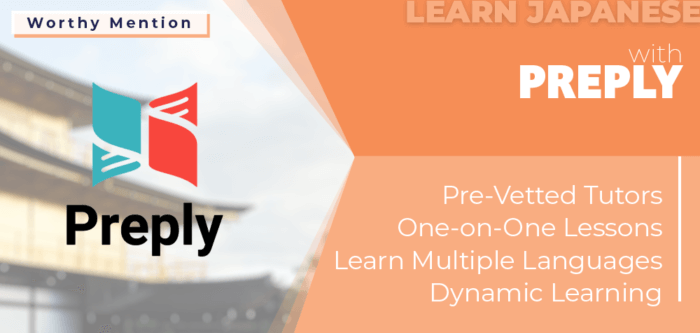The internet is full of wonders and if you’re interested in the best way to learn Japanese, it can connect you with just the right websites and tutors to help you along the way. Although going to Japan could help you by being immersed within the culture, forcing you to learn the language more quickly, you can learn Japanese from the comfort of your own home—wherever you’re located. Online, you can get all the lessons you need that teach you vocabulary, grammar and punctuation, as well as pronunciation. You can select a website or tutor based on your unique learning style and the best part is you don’t have to wait to get started. You can begin to learn Japanese and start practicing as soon as today.
Learning Japanese is almost like learning an art form. It’s spoken quickly and it’s written completely differently than English; in fact, it uses three writing systems and sometimes these systems are even blended into the same sentence. To get you learning and speaking Japanese quickly, we selected the top three learning sites and tutor sites that can get you connected with this beautiful language. Whether you’d just like to learn a couple of words casually, would like to spend your time learning on your own, or would like to connect with a Japanese tutor, we selected the best options that you can pick from to learn at your own pace.
Top 3 Sites for Learning the Japanese Language
- Pimsleur – Editor’s Choice
- Rype – Runner Up
- Preply Tutors – Worthy Mention
How We Chose These Sites for the Best Way to Learn Japanese
To put this list together, we identified a set of criteria to keep us focused and unbiased. Our main goal is to deliver information in an easy to read format, so that you can decide which service might be best for your needs. At the end of the article, we answer some of your most frequently asked questions, so you have all the information you need upfront.
- Customer comments
One of the first things we investigate are comments. We chose three different types of options, all with positive customer feedback.
- Different methods
Since the way you learn Japanese might differ from another person, we created a list with a variety of different methods you could try.
- Affordability
Learning Japanese grammar and Japanese characters shouldn’t break the bank. We chose options that are affordable, so you could enjoy the process of language learning.
- Different learning styles
The best way to learn Japanese is different, depending on how you prefer to learn. We created a list that caters to different styles, so you can find a service that works for you.
Reviews & Analysis of Top 3 Sites for Learning Japanese
1. Pimsleur – Editor’s Choice

Pros:
- Functional vocabulary
- Easy to use
- Emphasis on pronunciation
- Encourages speaking
- Best way to learn Japanese
Cons:
- Use of formal language
Quick Overview
When you reach the Pimsleur website, you can select from their top languages and go ahead and start with a seven day free trial. The Pimsleur method includes core lessons, which are 30 minutes long and you can listen wherever you are. You’ll also get access to reading lessons, which help you learn to read in Japanese. Try out the speak-easy challenge, which involves role-playing while you review your transcribed conversations. If you can’t make do without your flashcards, you’ll love that Pimsleur provides digital flashcards that allow you to practice vocabulary and dive deeper into the written language.
You’ll be able to build your skills with each new lesson and practice common phrases to get you acquainted with Japanese. You can also expect additional perks like a speed round game that allows you to test your conversational knowledge in a fun, fast-paced environment. You’ll be able to connect more deeply with the culture and history of Japan to further enhance your language learning. And you can stream live or offline using the Pimsleur app that goes wherever your phone goes.
How it Works
Pimsleur courses use the Pimsleur method which involves asking a question, having you recall it, and confirming your response. With this method, you get interaction that forces you to remember the words you’re learning. It helps you create a foundation of the Japanese language while improving your ability to speak it. Pimsleur has a strong focus on pronunciation, which is ideal for getting you ready to communicate in social settings. Pimsleur also splits up Japanese speech which is typically very fast paced. It does a great job of breaking down all of your new vocabulary words syllable by syllable, so that as you get acquainted with a new word, you’re also learning how to say it in a slowed down fashion. When you know each syllable’s pronunciation, you can practice saying the word at a regular rate of speech.
Cost and Other Details
You can select one of two plans: the Pimsleur premium plan that includes Japanese only or you can get the best value plan, the Pimsleur all access plan that includes 51 languages for only $20.95 per month after your seven day free trial. If you do choose to purchase the Pimsleur premium Japanese only plan, that cost is $19.95 a month after your seven day free trial. The moment you sign up with either plan, you get immediate access to all lessons and available features. You also get driving mode so that way you can study on your regular commutes. You’ll be able to download the mobile app and enjoy bonus content that allows you to expand your vocabulary.
2. Rype – Runner Up

Pros:
- 10 languages with one membership
- One-on-one lessons
- Professional language tutors
- Personalized learning
Cons:
- Short sessions
Quick Overview
Rype serves as an online marketplace that connects language learners with professional, pre-vetted tutors. It’s a program that allows you to schedule learning sessions on your own time and connect in real time with a tutor who walks you through learning Japanese. If you’re the type of person who needs one-on-one communication to help you understand concepts better, you’ll love that this platform personalizes the learning process instead of leaving you to study on your own. With a one-on-one tutor, you get immediate feedback that lets you know what you’re excelling in and where you may need to work a little harder. If you’re all in with learning Japanese and want to accelerate the learning process, Rype’s platform can get you connected with a tutor that supports your goals.
How it Works
You first need to create an account with Rype. Once that is all set up, you can begin answering questions that allow Rype to customize your learning experience. You can declare upfront how much time you will commit to learning on Rype each month. Once you designate your time commitment, you can browse different available teachers so you can book a lesson with a tutor who has the right background and who you feel you would work well with.
When you select a tutor, they will work with you to create a learning plan and will advise you on how to navigate any future lessons. If you prefer to browse by availability instead of by tutors, you can set up your preferences that way. After your first lesson with a tutor, you’ll be provided with feedback to gauge where you are, and you’ll also be given some offline lessons you can complete on your own time to supplement the one-on-one time.
Cost and Other Details
You can start with private lessons at $14.00 per hour. You can designate upfront how many hours you want to pay for in a month’s time. To skip one-time lesson rates, you can sign up for a prepaid six month membership. With this option, you get four hours of private one-on-one lessons each month for a total of $359.94. When you subscribe to this membership, you save 40% off the regular one-time costs. You also have flexibility to switch plans or cancel at any time—if you feel four hours isn’t enough, just switch your plan to include more hours and you’ll have access to more time with your tutor.
3. Preply Tutors – Worthy Mention

Pros:
- Connect with native Japanese speakers
- Choose your price per hour
- Over 750 Japanese tutors
- 100% satisfaction guarantee
Cons:
- It may take a few tries to connect with the right person
Quick Overview
Preply makes learning Japanese easier by connecting you with a network of Japanese tutors who are ready to dedicate their time to help you learn. Start with the search bar at the top of the page when you visit the Preply website to select Japanese as your language and select the price per hour you’re most comfortable with. The highest per hour rate is $40.00 while the lowest is $1.00. You can also select which country you’d like your tutor to be from and can designate your availability using their calendar.
Beyond the main filtering options, you can also select specialties, like “Business Japanese” or “AP Japanese Language and Culture” from the list. If you’d like to communicate with your tutor in your native language, you can also select your language from the dropdown menu titled “Also Speaks” to make sure your tutor can communicate in your native language throughout the lessons.
How it Works
First, you decide what type of tutor you’re interested in working with. You can browse different tutors, read through their profiles, and watch their tutor videos to get an idea of their pronunciation and understand a little more about their personality and teaching style. You can book a free trial lesson with a tutor to make sure they’re a good match for you. When you have completed the initial lesson and decide to move forward with that tutor, you can buy a set of hours with them.
The more hours you buy at once, the more discounts you can get from Preply. Keeping your satisfaction in mind, Preply allows you to transfer any unused hours to a new tutor if your experience is less than favorable. You can also request a refund if you’re not satisfied with the experience. This flexibility is meant to encourage confident purchasing; Preply wants you to connect with a tutor that helps you achieve your goals.
Cost and Other Details
You can select the total amount per hour you’re comfortable paying. Simply designate the range you’re comfortable with in the search bar and only tutors within those rates will show up on your screen. You can always enjoy a free trial lesson with a tutor; these sessions span the course of one hour. Any lessons after your trial lesson can last anywhere between 30 minutes to three hours and 30 minutes. This is decided between you and your tutor. If you prefer to have intensive sessions, you can book them for three hours at a time, and if you know how many hours you’d like to spend working with your tutor over the course of a month, you can purchase them ahead of time to enjoy extra savings.
Japanese Is an Exciting Language
Japanese has an interesting history and there are facts about the language you probably don’t know. Below we list some intriguing information about the language to get you even more excited about picking it up!
Japanese is not tonal
Tonal languages use less unique words and less distinct syllables. Instead of ultra-distinct syllables, tonal languages rely on inflection to create differentiation between words. A good number of Asian languages are tonal, but Japanese is not. In fact, Japanese is unique in that it did not follow through with surrounding countries to create its language system. Since tones are difficult to learn, this may bring you some relief. Instead of having to learn and perfect different tones, you can listen to Japanese speakers to pick up on the rhythm and cadence used with vocabulary words and full sentences.
The Japanese language is adaptable
The Japanese alphabet system incorporates foreign words with variations that allow for easy pronunciation in Japanese. In fact, a whole new set of 48 unique syllables are included in katakana, the adapted Japanese alphabet. This shift originally started in 951 AD, when katakana was used to increase understanding of Chinese writing for Japanese readers. This adaptability demonstrates how the native tongue has been impacted by other cultures and languages.
Japanese is number nine
The Japanese language is the ninth language most spoken globally. Unlike other languages, people who speak Japanese live primarily in Japan. However, there are places where learning Japanese is becoming prevalent, like Hawaii for instance. Globally, people are seeking to learn Japanese and get better acquainted with Japan’s fascinating culture.
Formality is addressed with verb conjugation
When learning Japanese, you’ll conjugate your verbs differently depending on the level of formality you’re using in your speech. This aspect of the language is constantly being refined, with even native speakers having a hard time deciphering between when they should use each verb. That’s because you can either speak in a casual way with friends, in a polite way with strangers, or in a formal way when you’re speaking to a manager at work or when otherwise conducting any type of business meeting.
Japanese doesn’t have plural words
As you learn Japanese, you’ll come to realize that the Japanese language does not have any plural words. For example, if you point at the sky and note that you see a bird, there is no difference between saying you see a flock of birds or a single bird. This can make it difficult in terms of identifying quantity, but it’s something you get used to.
How Long Does It Take to Learn Japanese?
The Japanese language is complex. It differs significantly from the English language, which makes learning Japanese a worthwhile yet tedious process. You have to pick up on Japanese characters, Chinese characters, and you have to learn Japanese grammar as well. It will take some time for you to reach fluency in the language.
In fact, according to the US Department of State, if you are an English native speaker, Japanese may be one of the hardest languages for you to pick up. This is because the English language and the Japanese language don’t have a lot of similarities in the way that they are structured. On average, the US Department of State estimates that it may take around 88 weeks of consistent language learning for you to reach fluency.
Some English students may take up to 4800 hours to be able to pass the Japanese language proficiency test. If you are interested in being able to watch anime while understanding every spoken word and would like to connect seamlessly with locals while visiting Japan, give yourself a couple of years to study and practice the language so you can reach mastery.
Tips On Remembering New Vocabulary
Although you may think that rote memorization is your only avenue for remembering words as you learn Japanese, there are actually a couple of different strategies you can use to make learning Japanese easier and more enjoyable. Rote memorization just refers to typical learning strategies, like flash cards that include the new vocabulary word on one side with the definition written on the other side.
Try the keyword mnemonic method
With this method, you start with any vocabulary word and associate it with a word in your native tongue. By creating a link between the new word and a word you’re already familiar with, you help the memorization process. As you create associations with keywords in your native language, try to make them as vivid in your imagination as possible. When you can trigger an image in your mind, this helps to accelerate the learning process. To take it a bit further, you can incorporate some of your different senses in your imagination. For example, you can identify a scent or a sound as part of the association you create between the new vocabulary word and your keyword. As you develop and learn Japanese, you will have created an entire world of associations in your mind that’s unique to your imagination and your learning style.
Spaced repetition system
The space repetition system is one of the most commonly used methods for memorizing vocabulary words. In fact, it’s a popular system used for any type of memorization, not just vocabulary words. This is because the system engages your long-term memory as opposed to your short term memory. With this method, you create a goal for yourself to memorize a certain number of vocabulary words. As you practice learning the new words, some of them will be easier to remember than others. If, after a few days, you feel pretty good about five or 10 new vocabulary words, you can set those aside and continue studying the ones that you’re having more trouble with. By the next week, you can periodically study the old words just to make sure that you do remember them accurately, while you keep learning the new words. As the weeks progress, you’re spacing out the repetition and transferring the new knowledge into your long-term memory.
Start with commonly used words
This might seem obvious, but there are so many words in Japanese that you can start learning that you might not know which are more valuable to you in the beginning. You can use a Japanese textbook or any of the services we presented to help you identify which words are the most commonly used in the Japanese language. You can learn Japanese words depending on their different categories, like clothing or adjectives. When you group words into different categories, it’s easier for your brain to remember than if you just present a jumble of different words.
Lean on your dictionary
As you continue with Japanese language learning, you’ll rely on an English-Japanese dictionary. This way, you have easy access to the translation of each new vocabulary word. Be mindful as you use translations, as some words may be synonymous, but they do not have the same meaning.
Learn kanji
Kanji is used regularly in Japan, so if you ever plan to travel to Japan, you’ll find your understanding of kanji comes in very handy. Although you can speak Japanese without learning kanji, because it’s so embedded in Japanese culture, you’ll miss a lot if you don’t have a solid understanding of it. The more you study it, the easier it gets. You’ll be able to pick up on different patterns in kanji and pick up on more nuanced expressions.
Learn Even Faster by Getting to Know the Culture
You’re definitely going to have dedicated study time as you learn Japanese but it’s also important that you surround yourself with Japanese culture and the Japanese language so that you can get even more familiar with it. Try listening to Japanese podcasts and TV shows. If you’re a fan of anime already, then you can cross that off your list.
Ultimately, you want to surround yourself with native Japanese speakers. If you are not studying in Japan or you are not surrounded by people who speak the language, part of language learning is incorporating other resources to get your brain familiar with all the different words and pronunciations. The more you immerse yourself in Japanese culture, the faster you’ll pick up on different vocabulary words and also on Japanese grammar. Sure, you can learn Japanese grammar when you are studying on your own but there’s nothing quite like learning the Japanese language by studying the way it’s naturally spoken. In fact, this is probably the best way to learn Japanese along with your regular studying.
How Many Hours Should You Study Japanese?
There is no one-size-fits-all answer to this question. It’s important for you to be realistic with your goals. If you have a full-time schedule to devote to learning, you can schedule your days with multiple hours of study time per day. However, it’s also important you consider your learning style and take breaks as needed to make sure new information has enough time to settle. If you’re juggling work and other responsibilities while expanding your understanding of Japanese, you may only have a few hours per month to dedicate to learning. Create a customized plan that works for your schedule, so that you can remain consistent with the goals you set for yourself. If you try to do too much at once, you may burn yourself out prematurely. It’s better to keep your studying slow, steady, and realistic.
Conclusion
When you understand your learning style and dedicate yourself to learning a new language, the results can surprise you. Even though Japanese is considered one of the hardest languages to learn, with tools and one-on-one time with tutors, you can make your learning experience easier, and even fun! Be realistic when you set your goals and commit to a certain amount of study hours each month. Watching yourself progress is a reward in and of itself—but imagine—in just a few short years, you can be walking through Japan, connecting with the locals in their native tongue, and enjoying everything the culture has to offer.





































